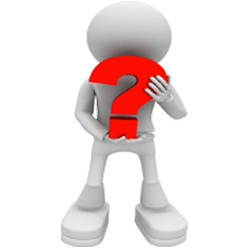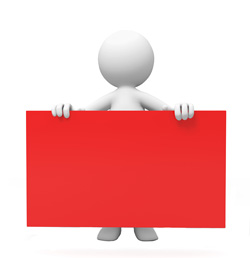“You know what I want. Just make it look good." These are the "famous last words" of our customers. These are also the same words that your embroidery professional really does not like to hear. Right after someone makes this comment I always hear (in my head) that sound that comes right before something bad happens in a scary movie. That is because your customer just bailed out on taking the responsibility for the overall look of the order. You (and your decorator) now have no idea if the customer will like the final result, love the result or possibly hate the result when he sees the completed order. This puts you and your apparel decorator at risk.
 Here's one solution for when your customer makes this comment – respond with a statement that the customer generally cannot ignore, "Wow, I'm not sure what you are expecting. I want to be sure that you are really pleased." And then ask about the size of the lettering or the size of the design, or ask a question to confirm or clarify the color choices. These queries will help you find the large and small tolerances of what they will like and accept for their design and their order.
Here's one solution for when your customer makes this comment – respond with a statement that the customer generally cannot ignore, "Wow, I'm not sure what you are expecting. I want to be sure that you are really pleased." And then ask about the size of the lettering or the size of the design, or ask a question to confirm or clarify the color choices. These queries will help you find the large and small tolerances of what they will like and accept for their design and their order.
If the design is going to be placed on the chest area of a shirt or on a bag, the best question is, "Do you want the embroidery to be about the size of this business card?" This is a perfect question for several reasons. First, the proportions of a business card are visually appealing and surprisingly enough, most chest designs that fit within that 2" x 3.5" area will look appropriate on a shirt or bag. Second, your customers usually can visualize their logo on the shirt or product fairly easily when you lay their business card on that shirt or the product. It makes a great starting point as you try to clarify the range of "knowing what they like," simply and efficiently. Third, if they say they want the design to be larger or much larger than the business card, which can often be the case, you can show them examples of designs on some of your samples, and then lay the card over each of the embroidered designs.
Even designs that are laid out in a vertical rather than horizontal alignment often are close to the dimensions of the business card. Depending on the shape of the design, they may go a bit taller. Lay the card on the shirt vertically instead of horizontally to demonstrate the suggested design size possibilities with those logos.
 Your customers will probably be amazed at how many chest designs are indeed covered or nearly covered by their business cards. Your customers usually happily select a design size that will look good on their shirts once they’ve seen your examples as “proof” of the best size for their design. Now you and your customer have the same expectations for the final product. It prevents that dreadful moment when the customer sees the order for the first time and exclaims, "Oh, I thought the logo was going to be larger!"
Your customers will probably be amazed at how many chest designs are indeed covered or nearly covered by their business cards. Your customers usually happily select a design size that will look good on their shirts once they’ve seen your examples as “proof” of the best size for their design. Now you and your customer have the same expectations for the final product. It prevents that dreadful moment when the customer sees the order for the first time and exclaims, "Oh, I thought the logo was going to be larger!"
It is a good idea to have at least one example of an oversized design on a golf shirt in your selection of examples. Choose a design that looks good but tends to look a bit too large, even if you have your own company’s logo on that sample garment. This will help your customers feel good about the final design size when they can see something that looks "too big." They may not know why they like the others better, but most of the time, they will go with the smaller business-card size design after seeing the larger design. The business card-sized designs generally look better on shirts and this size of design helps keep your cost in check, a win-win situation.
 If you have a customer who is really pushing for a large design, another tactic that you can use is to make sure that you are recommending thread colors with the highest contrast to the shirt or product. Low contrast or tone-on-tone designs (grey thread on a white shirt) look smaller than the exact same size of design sewn in black on a white or light-colored shirt, or the reverse, a white design on a dark shirt. For the highest contrast, go with the light colors of threads on a dark-colored shirt. The light-color designs on a dark shirt tend to appear larger, even when the exact same design size is embroidered.
If you have a customer who is really pushing for a large design, another tactic that you can use is to make sure that you are recommending thread colors with the highest contrast to the shirt or product. Low contrast or tone-on-tone designs (grey thread on a white shirt) look smaller than the exact same size of design sewn in black on a white or light-colored shirt, or the reverse, a white design on a dark shirt. For the highest contrast, go with the light colors of threads on a dark-colored shirt. The light-color designs on a dark shirt tend to appear larger, even when the exact same design size is embroidered.
If your customer is requesting more than one design or logo on a product, you have to consider the proportions and placement of both of the designs to create a final product that appears balanced. If you have ever seen a shirt with a tiny design on one side of the placket and huge design on the other side, you know exactly what I mean – it looks awful! Any designs that will be visible at the same time need to balance each other. The visual impact of one design should not completely overshadow the other.
You have much more leeway in the difference in the sizes of the designs if one design is going on the front chest of the shirt and the other design is going on the sleeve, shirt tail or back of the garment.
If the product you are adding a logo to has a clearly defined area where you would drop in the logo, you can jazz things up a bit by adding visual movement to the design – embroider the design at an angle instead of the traditional straight placement. Your customer may really like this as a fresh alternative to the typical placement. You can make it look good and provide something new, all while adding a design that does not overwhelm the space or the product.
Part of your job when selling embroidered apparel is to advise and guide your customers to help them make choices that will ensure they look great wearing the apparel and using the products that they order from you. When some customers say, “I want it as large as possible,” that does not mean fill the shirt when it comes to what is embroidered. You still have to make them happy yet not let them look ridiculous. When some customers say, “Just make it look good,” bring them along in the process so that your version of what looks good will more than meet their expectations. When they love the final result, they will be back for future orders!
Jennifer Cox is president of the National Network of Embroidery Professionals. NNEP members receive personalized marketing consulting designed specifically for their business. To join NNEP today, visit NNEP.net, email Jennifer at hooper@nnep.net, or call 800-866-7396.